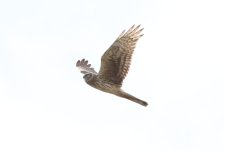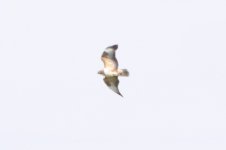Henry_Flower
Well-known member

Can anyone help with a couple of IDs from a visit last week to Geiseltalsee (lake surrounded by fields) in Germany?
The first I think is a hen harrier (rather than Pallid or Montagu's) -- I'm not familiar with the other harriers, but I gather five fingers rather than four rules them out?

The second is an unfortunately very windy recording -- Merlin suggested Northern Wheatear, which fits for the area, but it doesn't sound very much like the recordings I've heard. Is it possible to ID based on the recording?
Edited to add: sorry, one more from the same time and area but very distant -- I initially assumed this was a marsh harrier, but the dark head and white chest don't seem to fit?

The first I think is a hen harrier (rather than Pallid or Montagu's) -- I'm not familiar with the other harriers, but I gather five fingers rather than four rules them out?

The second is an unfortunately very windy recording -- Merlin suggested Northern Wheatear, which fits for the area, but it doesn't sound very much like the recordings I've heard. Is it possible to ID based on the recording?
Edited to add: sorry, one more from the same time and area but very distant -- I initially assumed this was a marsh harrier, but the dark head and white chest don't seem to fit?

Attachments
Last edited:






